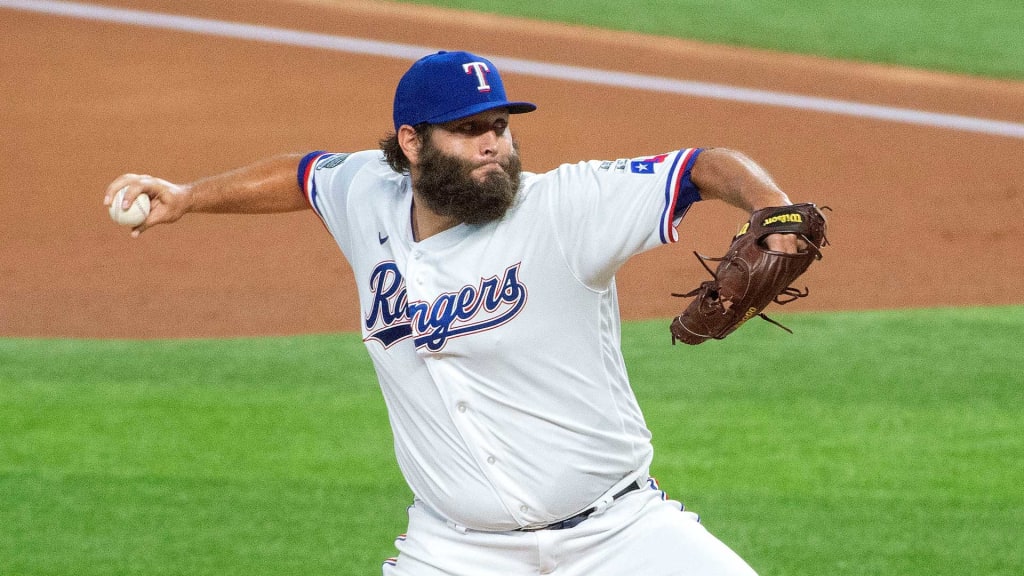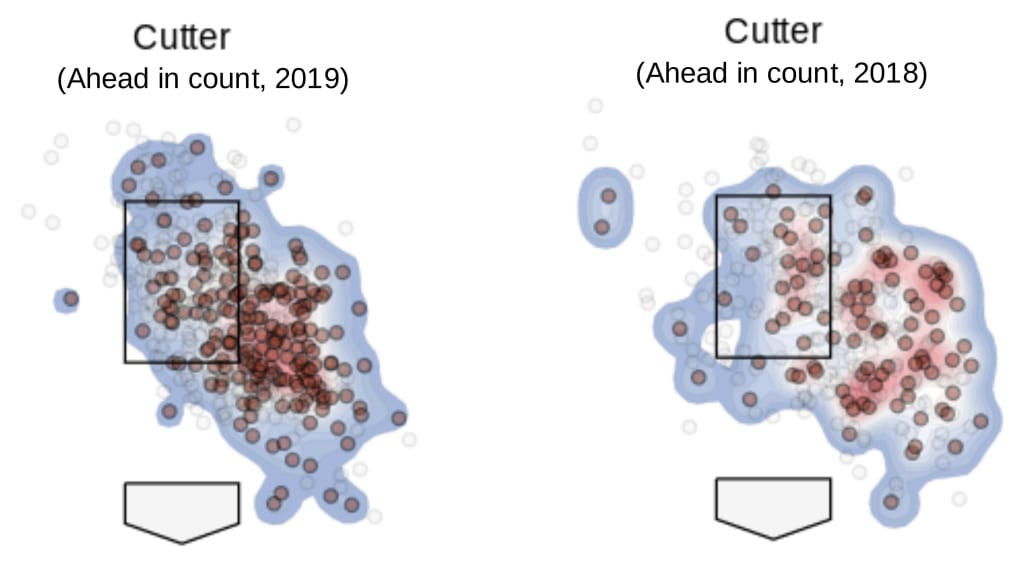
Rangers right-hander Lance Lynn isn’t flashy. He doesn’t have triple-digit heat, or a GIF-worthy breaking ball. And he’s been around long enough that he was teammates with Albert Pujols in St. Louis. But the bearded veteran became a top-of-the-rotation force at age 32 last season, and he’s showing no signs of turning back in 2020.
Lynn, who turned 33 in May, is coming off a fifth-place finish in the American League Cy Young Award voting after going 16-11 with a 3.67 ERA (141 ERA+) and a career-high 246 strikeouts in 208 1/3 innings.
His 7.5 Wins Above Replacement, per Baseball-Reference, ranked third among all pitchers, behind teammate Mike Minor and the Mets’ Jacob deGrom, who won his second straight National League Cy Young Award in 2019.
Prior to 2019, Lynn had long been a solid mid-rotation arm, making at least 29 starts in six of seven seasons from 2012-18 and posting a 3.58 ERA (109 ERA+) in that span. However, his previous best in bWAR was 3.6 in 2014.
After recording a career-high 4.82 FIP in 2017 -- his first season back from Tommy John surgery -- Lynn rejected the Cardinals' qualifying offer and was met with a chilly free-agent market, ultimately signing a one-year, $12 million deal with the Twins. His tenure in Minnesota lasted just 20 starts, and he had a 5.10 ERA with 62 walks in 102 1/3 innings during that time.
However, a move toward the third-base side of the rubber that summer unlocked something within Lynn, who showed improved command following a trade to the Yankees in July, recording a 61-to-14 K/BB ratio in 54 1/3 innings. It proved to be a harbinger of things to come.
Lynn subsequently inked a three-year, $30 million contract with the Rangers that has turned into a bargain. After last season’s success, Lynn has fired 12 scoreless innings in two starts against the Rockies and D-backs this year, allowing only three hits and striking out 17 with six walks.
Lynn is scheduled to make his third start of the season Tuesday against the A's in Oakland. The last time he faced them, he fanned 12 batters over 5 1/3 innings last September.
Here’s how Lynn made the climb to ace status in 2019, and why he seems poised to retain that title moving forward.
His four-seamer became an elite weapon
Lynn may not throw 100 mph, but he did see a noticeable velocity bump last season, averaging 94.6 mph with his four-seam fastball. That number was 93.7 mph in 2018 and 92.4 mph in ’17.
Perhaps emboldened by the increase in velocity, he started throwing his four-seam fastball more -- 54.1% of the time, to be exact, up from 44.9% in 2018 and 36.7% in '17.
Lynn ended up leading MLB with 1,858 four-seamers thrown, and he fired a whopping 61.4% of them in the strike zone, the highest among all pitchers who threw at least 400 four-seamers. And yet, he still managed to miss plenty of bats. In fact, his whiff rate (misses/swings) on four-seamers placed him directly behind two of the most dominant starters in the game.
Highest whiff rate, SP, 2019
Min. 200 swings on four-seamers
1. Gerrit Cole -- 37.6%
2. Justin Verlander -- 31.1%
3-T. Lance Lynn -- 30.7%
3-T. Jake Odorizzi -- 30.7%
5. Mike Clevinger -- 30.0%
Lynn’s 30.7% whiff rate on four-seamers was a dramatic increase over his mark from 2015-18, when he had a 26.3% whiff rate with the pitch while averaging 93 mph.
Lynn’s reliance on his four-seam fastball has been even more pronounced so far in 2020. Through his first two starts, his four-seamer usage rate is 64.8%. Hitters have gone 2-for-26 (.077) with 12 strikeouts in 30 plate appearances ending on Lynn’s four-seamer.
He improved his cutter command
Lynn’s improvement with the four-seamer last year was about more than just a bump in velocity, as he also developed his cutter -- a pitch he started throwing in 2017 -- into a solid secondary offering that he could play off his four-seamer, particularly when he was ahead in the count.
In 2019, Lynn often threw both his four-seamer and his cutter to his glove side (away from righty hitters, inside to lefty hitters) while ahead in the count, with his four-seamer staying up and his cutter breaking down. The pitches looked similar enough at the hitter’s decision-making point that Lynn was able to create deception and prevent batters from sitting on his four-seamer (more on that below).
The year before, Lynn wasn’t able to consistently throw his cutter close enough to the strike zone to fool hitters, which probably explains why he used the pitch only 12.7% of the time while ahead in the count, compared to 19.7% in 2019.

Lynn’s move to the third-base side of the rubber in the summer of 2018 likely had a lot to do with his sudden ability to throw his cutter closer to the zone last season.
He started using his sinker less
In recent years, we’ve seen an MLB-wide reduction in two-seamer/sinker usage, dropping from a 20.3% rate in 2016-17 to 19.2% in ’18, 16.0% in ’19 and 14.5% this season (through Sunday) -- a pattern Lynn has mirrored.
Lynn’s sinker was an effective pitch in 2017, as he held batters to a .252 average and a .371 slugging percentage with it while throwing it 42.6% of the time. Although it was far less reliable the following season, yielding a .310 average and a .419 slugging percentage, Lynn still threw it on nearly a third of his offerings (32.5%).
Lynn continued to struggle with the pitch in 2019, allowing hitters to post a .325 average with a .470 slugging percentage, but his usage rate dropped to just 17.2%, mitigating the damage.
Through two starts in 2020, he has thrown only 14 total sinkers for a scant usage rate of 6.7%.
Throwing fewer sinkers has especially helped Lynn against left-handed batters, who had an .828 OPS with only 107 K’s in 693 total plate appearances against the righty over 2017-18 -- a span in which they hit .314 with a .494 slugging percentage against his sinker. Since the beginning of 2019, lefty hitters own a .691 OPS with 112 strikeouts in 491 PAs against Lynn.
While the reduction in sinkers in favor of more four-seamers and cutters has led to a rise in whiffs and strikeouts for Lynn, it also predictably has caused his ground-ball rate to drop from 47.5% over 2017-18 to 40.1% since the start of ’19.
However, the increase in air balls hasn’t coincided with a rise in homers. Even with long ball rates skyrocketing around the Majors, Lynn allowed just 21 homers in 208 1/3 innings (0.9 HR/9) last season, and he hasn’t given up one in 2020.
Interestingly, while Lynn has followed a trend in throwing fewer sinkers, he hasn’t done the same with the MLB-wide increase in breaking balls over the past few years.
Lynn throws one breaking ball, a low-80s curve, and his usage rate on the pitch held steady between 2018 (9.1%) and ’19 (9.5%), even as his curveball limited hitters to a .170 average with a .241 slugging percentage while generating a 36.4% whiff rate in that span. The righty has tallied seven swinging strikes and two K’s on his 14 curveballs in 2020.
So, how does a pitcher who threw a fastball (four-seamer, sinker, cutter) over 87% of the time in 2019 manage to keep hitters off balance?
He mastered the art of tunneling
As MLB.com’s Matt Kelly pointed out last August, Lynn’s breakout was sparked by his ability to “tunnel” his pitches, which means throwing two different pitches on the same trajectory long enough that they look nearly identical at the point a hitter needs to make a decision whether to swing or take.
According to Baseball Prospectus’ (subscription required) tunneling metrics, Lynn had MLB’s fifth-lowest average pre-tunnel maximum distance, the perceived distance between back-to-back pitches from a hitter’s point of view, and he tied for the second-lowest pre-tunnel max time, a stat that shows when the second pitch in a pitch pairing is at its greatest perceived distance from the one preceding it. For both of these stats, the lower the number is, the better.
So while Lynn changed speeds and locations with his three fastballs, his tunneling made it difficult for hitters to tell each pitch apart at the decision point.
What remains to be seen is if Lynn continues the pitch-usage pattern he's shown so far in 2020, relying mostly on two pitches (four-seamer, cutter), and if it's possible for him to use his four-seamer too much. To this point, though, it hasn't caught up with him, and he may keep rolling with it until it does.



